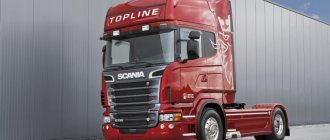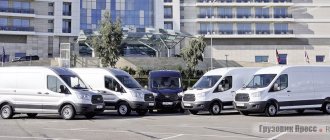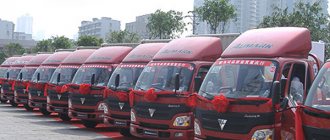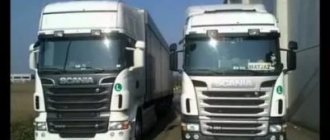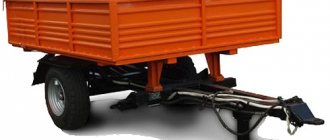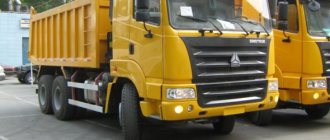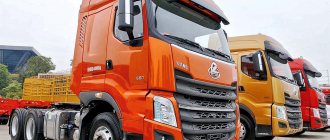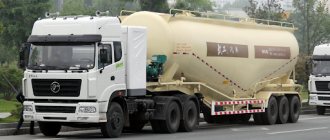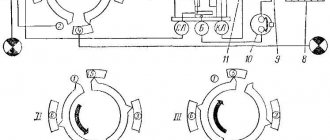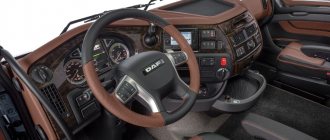Having attended the premiere of the latest generation Scania long-haul tractor, we were able to not only get acquainted with all the innovations that the truck is simply packed with, but also test it in real conditions on the roads of Sweden.
Scania S & R Series 2016. Gross weight: over 16 tons. Start of sales: autumn 2016. Price in Western Europe: depending on the configuration.
Let's start with the fact that almost 21 years passed before Scania launched a new generation of trucks. To some this may seem like too long a period, but trucks change generations on average once every 20 years. The investment in development, the time required to prepare for production and fine-tuning the machines is too high. The Skanievites themselves talk about this.
The development of the new truck required 10 years and an investment of $2.35 billion. The prototypes traveled more than 10 million km along roads of different continents and climatic zones.
Now Scania's main task is to organize test drives of new cars for at least 40,000 existing and potential customers of the company. This will allow them to become more familiar with the entire Scania product range - from environmental enhancements to financing, insurance and maintenance options. And Scania itself can find out the backlash to its product.
“This is undoubtedly the largest investment in Scania's 125-year history,” says Henrik Henriksson, President and CEO of Scania. “My colleagues and I are immensely proud that we are now introducing products and services that will enable Scania to increase its market share and ensure its success over the next 10 years.”
So, what's new in the latest generation of Scania trucks?
THE TRUCK STARTS WITH THE CAB
According to some estimates, the cab accounts for up to a third of all costs when creating a new truck. The new Scania is truly completely new: from the frame to the filling.
The angle of inclination of the aerodynamic fairing can be adjusted by yourself
I can't say that she amazed me. Quite the contrary, my colleagues and I were expecting something more. However, over time, its perception settled in my mind, and no more questions about the design arose. In general, the design is fresh and, importantly, recognizable.
The new generation of cabs was developed taking into account four priority areas: driver working conditions, economical driving, optimal use of interior space, maximum safety and reliability.
Within the framework of the modular system professed by Scania, we can talk about at least 24 types of cabs. This will allow Scania to produce different cabs depending on customer needs.
The chassis layout is very tight
The cab frame was developed by Scania employees in close cooperation with Porsche Engineering. In terms of assembly, the new cabs differ in every way from the existing Scania lines, but at the same time their positive characteristics are preserved and enhanced.
High-strength steels are used as materials. Frame elements are made using both traditional and innovative technologies. They are connected to each other using welding, including laser. This creates a high-strength load-bearing structure.
The exterior design focuses on aerodynamics and, accordingly, fuel consumption. All front, side and even bottom surfaces are optimized for minimal air resistance. This was taken into account even when developing wipers, rear-view mirrors and optics. As an example, a non-standard sun visor was used. Both the air deflectors and the side fairings do not stand out from the general appearance, and their design is thought out as carefully as that of other parts. As a result, the total fuel economy from all innovations is achieved at 5%.
High beam - a “trick” from Scania
In all cabs in the new range, the driver's position is 65mm closer to the windscreen and 20mm closer to the side wall compared to the current generation cabs. This is done primarily to increase safety and visibility from the driver's seat, as well as to increase interior space (in particular for adjusting the bed and seat).
The dashboard is lowered slightly compared to previous models, which improves visibility in front of the truck. Particular attention was paid to ensuring that each driver had enough knee and leg room, even if they were wearing warm, thick clothing and large boots. The redesigned instrument panel also makes it easier to move around inside the cabin when the vehicle is parked. As an option, even a steering wheel with a bevel at the bottom is offered. Either as a joke or seriously - it will be more convenient for German drivers who have a fair amount of belly.
There are even more options for storage space, with a special emphasis on volume and accessibility. The cabin layout is carefully thought out and space is used efficiently. Depending on the cabin option, the chosen bed and other specific needs, you can choose a variety of storage containers, hooks and nets. There is a particularly wide selection when it comes to beds. Lower beds, like upper beds, have different designs and functionality depending on specific wishes and comfort requirements. Thus, in the S-type cabin you can install two beds with a width of 80 cm (the lower one can be expanded to 100 cm). They all have new mattresses.
New cabin - new interior. Even more pathetic
An additional option is a passenger seat that can swivel and recline for greater ergonomics and comfort in the cabin. There are a variety of interior lighting options available, allowing users to dim the lights and change the ambiance. Lightproof curtains have also been improved: they are made from new material and have become easier to use. The interior sun visors can be lowered individually and are easily adjusted on the go thanks to a convenient mechanism.
Scania has also developed completely new climate systems. Additional heaters can be installed in any cab, and a fully integrated air intercooling system can be ordered directly from the factory. It is integrated into a standard climate system so that heated or cooled air passes through special ducts and is controlled using a standard climate control panel. This ensures a more even climate, quieter operation of the system and uniform distribution of the desired temperature. Additional heaters are available with remote control and can also be used with alternative fuels.
When it comes to infotainment systems, it comes down to two well-integrated systems with 5- or 7-inch screens. Integrated steering wheel switches are standard, as is voice control via the roof microphone.
But the armrest on the door took some getting used to
The new generation of Scania cabs can be equipped with side airbags to provide protection in the event of a rollover. They are mounted directly into the cab roof, which has not previously been used in truck construction. Together with seat belts, side airbags create a reliable protective system in case of an accident.
At the same time, the design of the new cabin made significant changes to the model range. Firstly, the top-end cabin of the S series (Highline) with an almost flat floor (there is a small protrusion of 20 mm) appeared - CS20H. The maximum height of the living space is 207 cm.
Secondly, the R19T Topline version has disappeared from the range of cabs. From now on, the R series will be led by the CR20H variant with a maximum living space height of 181 cm. This is only 10 cm less than the previous generation in a comparable version.
Instrument panel with the same “self-criticism”
At first glance, it may seem that the new cabins have lost some useful volume, but this is only an apparent impression, since the length of the cabin has increased, and in the top version the engine tunnel has disappeared.
The new cabs are manufactured in a newly built plant in Oskarshamn, Sweden.
Scania truck review
Swedish Scania vehicles are one of the most popular trucks in the world today.
Initially focusing on superior quality, Scania continues to follow this strategy to this day and produces vehicles that can compete with European brands.
In this article we will talk about the main series of trucks of the Swedish company.
Series P
These are classic Scania trucks.
Trucks of this series are used by large construction, furniture and highly specialized companies for regional and local cargo transportation.
Scania P series trucks are great for short trips.
Due to the small size of the vehicle, the carrying capacity increases.
The big advantage of the Scania P series is its economical fuel consumption and trouble-free operation during operation.
The driver's seat is equipped in such a way that it is as comfortable and convenient as possible while driving - an excellent view of the road is provided and a seat with many adjustments is installed.
Series G
These trucks came after the P series.
They continued the company's tradition of being ahead of the curve and acquired an improved set of capabilities for relatively long-term cargo transportation.
G-Series trucks are purchased by construction and specialty companies to transport their goods throughout the country.
Combining a functional, large cab and compact external dimensions, Scania G trucks are designed for long-distance transport.
The standard body can be replaced with additional equipment.
Trucks in this series are easy to operate and economical.
With minimal operating costs, Scania G offers maximum uptime and reliability.
G series trucks are the most popular on Russian roads.
Series R
Trucks in this series are distinguished by maximum power, comfort and reliability.
First introduced in 2004, the R Series trucks instantly won not only the trust of customers.
But there are also many special awards at prestigious competitions - for example, the Scania R series is recognized as the most powerful truck in the world.
Trucks of this series are designed to cross long distances with a minimum number of stops.
The cabin, equipped and decorated to the latest standards, contributes to the most comfortable trip over long distances.
They are able to cope with almost any obstacle on the road, and the 8-cylinder engine facilitates this.
Good luck to everyone on the roads!
POWER LINE
In the new line of Scania trucks, all engines are Euro 6 standard. They are equipped with new control systems, and the power plants themselves are completely modernized. The complex of work carried out made it possible to further save fuel by an average of 3%. With the launch of the new truck, Scania is also introducing a new version of its 13-liter in-line engine with 500 hp. With. In addition, a new gearshift function is being introduced, which allows Scania Opticruise to change gears faster and provides a virtually constant flow of power.
From now on, all four 13-liter Scania engines (370, 410, 450 and 500 hp) led by a new 500 hp version. With. Equipped only with an SCR system for exhaust gas purification. The variable geometry turbine has disappeared. Other changes include upgraded combustion chambers and new injectors, which provide fuel savings of up to 0.2–0.5%.
As an option, the cabin can be raised using a servo drive. There is even a remote control panel
The introduction of an oil cooler thermostat allows you to control and optimize the temperature of the engine oil, preventing it from overheating. When the oil cooler thermostat is closed, oil flows directly into the lubrication system. When open, oil flows into the oil cooler. This innovation helps to further save up to 1% on fuel, as it helps maintain optimal oil temperature even at partial load and at low outside temperatures.
V-shaped “eights” have also undergone a number of improvements. In three power variants - 520, 580 and 730 hp. With. — they retain exhaust gas cleaning with the EGR system in addition to SCR.
Scania's adaptive cruise control system has also been upgraded: it can now operate at any speed, even to a stop. Of course, this is a significant help for drivers stuck in traffic jams.
New Scania provides easy access to key systems
Another big news is that Scania has introduced a countershaft brake as standard in Scania Opticruise automated gearboxes. The countershaft brake reduces countershaft rotation speed during upshifts. Gear changes occur faster and with less wear on the synchronizers compared to gearboxes without it. This is made possible by Scania's use of integrated solutions: the shafts synchronize with each other much faster and the next gear is engaged almost immediately. The intermediate shaft brake reduces gearshift times in Scania Opticruise by 45%.
Scania also has other innovations to reduce fuel consumption. For example, the ability to select a rear axle with an even “longer” gear ratio of 2.35 in situations where the carrier knows in advance the nature of the goods being transported and the routes to be followed (in particular, on flat terrain).
September 5, Södertalje, Sweden.
Scania presents a new range – construction. At the same time, new products were shown in Australia, Brazil and some European countries. Practical Finns presented them two days later at their exhibition of construction equipment at Hyvinkää airport. Today is our first acquaintance with them.
The new family includes an endless number of models from two- to five-axle, with four types of cabs (familiar from previous generations of P
,
G
,
R
, and new
S
).
Three 9-liter engines, and four 13- and 16-liter engines, with power from 280 to 730 hp. All this is called HT
.
What these letters mean is not officially deciphered, but according to rumors, this is an abbreviation for e X
tremal
T
asks what these machines are aimed at.
01.
The Finns shortened the program and showed only cars that were interesting to the local market, and with local add-ons.
Here is a 650-horsepower Erka 6x4 timber truck with an automatic transmission and the famous Jyki
. The total weight is 30 tons, the front axle is 9 tons, the rear axles are 10.5 tons.
02.
Already known cabins differ in appearance from the road range in orange letters, the same abbreviation
XT
(remember other Swedes, with the
FMX
- from the same word e
X
treme).
03.
And the main difference is the durable steel bumper with a streamlined shape. It is moved forward from the front plane by 150 mm. You can “butt”, although not too much, without the threat of damaging the cabin.
04.
A simple folding step made from a pipe for wiping glass is attached to it.
05.
Its fastening with a simple spring is an inexpensive, practical and reliable solution, which is why Scania is loved.
06.
If you flip up the platform of the license plate, you will find a towing device designed for as much as 40 tons. Made to spare!
07.
As befits a construction series, the head optics are protected by a steel grille. To recline, you just need to press the stops at the top. Instead of running for an octagonal screwdriver and then picking at clogged slots, like some competitors.
08.
The rear view mirrors are housed in reinforced ribbed housings for added strength.
09.
And this is a four-axle dump truck with a short cab
G450
. In this color the car looks even more spectacular and much more “evil”.
10.
The interior, of course, is the same as the road range. Since the cabin is short, without a sleeping bag, the space behind the seats is given over to drawers and a refrigerator. It's convenient to throw a jacket on top.
11.
The lower step is folding, as is customary on such machines. But it seems redundant. Or is the dump truck designed for an overweight driver?
12.
The radiator grille has standard places for flashing orange LED lights. You can save money on upper beacons.
13.
The new family of tractors can be ordered in seven wheel configurations and different height options: super-low, low, normal and high.
14.
The chassis has even more wheel formula options - 14. From the simplest 4x2 to the rare 10x4/6, including all kinds of intermediate ones.
Alas, for us the new tracks are still of purely educational interest, because they are all Euro-6 level and require clean diesel fuel, which we do not yet have. We need to be patient for a year, and then, perhaps, their Russian premiere will take place.
CHASSIS
The truck chassis has been redesigned. The front axle is shifted from the standard position 50 mm closer to the bumper (the front overhang is reduced). On truck tractors this led to an increase in the wheelbase by the same amount. This was done to reduce the degree of forward tilt of the truck in the event of sudden braking (also by shifting the center of gravity of the cab down) and to make the truck more comfortable to drive.
Now the basic equipment of trucks is equipped with 30-inch brake chambers for front axle disc brakes. This further ensures high braking performance regardless of whether braking is applied by the driver or by the AEB system. Real-world braking distances are affected by factors such as tire and road conditions, but all things being equal, the new truck has a braking distance that is 5% shorter.
The new in-line “six” is not much inferior to the V-shaped “eights”. But it has become structurally simpler and more reliable in operation due to the absence of complex units
The design of the frame, suspension and other chassis elements have not undergone any significant changes. In general, they do not seek good from good.
LIVE
The road trains chosen for testing were Scania S580 (4×2) with a 3-axle Schmitz Cargobull semi-trailer with a total coupling weight of 36 tons and a Scania R450 (6x2/2) with an unusual 4-axle tank from LAG with a total coupling weight of 40 tons.
In all this there was the following reason: to compare cabins with a flat floor and with a motor tunnel, the traction capabilities of the “six” and “eight”, while not forgetting that regional roads in Sweden are narrower than in Russia.
In essence, nothing special happened in my mind when I first saw the new Scania interior. Everything is thought out to the smallest detail, is within reach, and the number of adjustments is more than enough. No wonder the press release stated that any driver with a height of 150 to 200 cm will be able to find a comfortable driving position. The only thing that caused confusion was the location of the headlight mode switch on the door armrest.
But what, so to speak, pleasure did I experience driving a road train on a specially selected route of 38 km, most of which ran along a road replete with turns, descents and ascents! Everything was at a high level - the truck’s traction capabilities, its braking performance, including the operation of the engine brake, and even adaptive cruise control.
What can you say if so much time and money was spent on developing a car that claims to be in the top segment. At least not in vain.
Do you need a driver? New Scania arrived in Belarus
The complete range of trucks from any major European manufacturer changes infrequently. One and a half to two decades is the usual period. During this time, families, as a rule, are repeatedly modernized, but between radically new models the gap is exactly that. The Scania line has also completely changed.
The European presentation of the new generation of Scania trucks took place back in 2016, and now the new Scania is finally arriving in Belarus. On Thursday, May 17, its presentation took place at the Lipki airfield.
We have attended many European truck presentations, so we can state that the Belarusian presentation, both in terms of the show and the presentation of the item, was organized no worse. Lighting, sound, special effects - everything is on the level. We especially note the fact that a decent part of the presentation was conducted in the Belarusian language.
But the main thing here is still the car. We got to know him better the next day and shared our impressions.
The most important thing is that we have before us a completely new generation of trucks, with everything new. And the cabin is also completely new.
When Scania developed the new range of cabs, the goal was to take as a basis and improve the design of the already proven P, G and R cabs. In the new generation of Scania cabs, the designers used all the accumulated experience in this field, and also took into account the results of hundreds of tests, suggestions from workshops and , no less important, driver reviews.
The frame for the cabins is made of high-strength steel. Its elements are made by pressing or twisting, and then connected using various welding techniques, laser soldering or high-tech adhesive equipment. In this way, a high-strength load-bearing structure is created. The new generation of cabs was developed by Scania's in-house designers in close cooperation with Porsche Engineering.
To achieve maximum fuel economy, attention was focused primarily on lightweighting the cabin structure and reducing drag. The Scania modular system includes at least 24 cab models. The system allows the production of different cabins depending on the transport need, be it interior space, economical driving, maximum comfort or load capacity.
The new cabins feature significantly improved visibility thanks to a larger glass surface positioned slightly lower than the instrument panel, thinner door panels and optimized A-pillars. Obviously, the rear view mirrors play a key role in this regard, their design has been developed to completely new standards aimed at aerodynamics and maximum visibility.
The cabin has a new suspension, a new anti-roll bar, and shock absorbers that reduce the lateral swing of the cabin and dampen its “nods” when braking.
Naturally, the interior has been thoroughly redesigned. The cabin has become higher and also longer by 10 cm compared to the outgoing 5 Series. At the same time, the range of adjustments for the steering wheel and seat has expanded. The developers not only improved the design and size of buttons and keys, but also optimized their combinations.
To prevent the driver from blindly reaching for the front panel, the light control was moved to the driver's door armrest. There is an interesting version of the steering wheel - D-shaped with bulges for the thumbs and a “cut” lower part, following the example of top versions of passenger cars.
The cabin can be traditionally equipped with two berths or one. The lower berth has become 10 cm wider and can be transformed by moving it back and forth.
The width of the upper sleeping bag is up to 800 mm. There are three types of innerspring mattresses to choose from.
Cab comfort is maintained by a new climate system with a humidity sensor and built-in parking heater/air conditioner.
Among the innovations in the interior decoration is a completely new microclimate system, including humidity and sunlight sensors. It is important to note that additional systems, such as the parking heater and auxiliary air conditioning, use the same standard air ducts, with all air passing through the cabin carbon filter. And with a recirculation system - through an additional air filter.
There are still storage spaces above the windshield, but with a larger volume. A kitchen module, which includes a microwave and coffee maker, can also be located here.
A few words about safety. Scania was the first truck on the heavy commercial vehicle market to feature side airbags. This means that in the event of a rollover, side impact or oblique collision, the risk of head injury to the driver is minimized.
To protect the driver, Scania additionally installs systems of adaptive cruise control (maintains a given distance to the car in front), emergency braking (it automatically stops the car if the driver does not react to an obstacle that appears in front of him), and warnings about leaving the lane. However, the last option can be disabled.
Over more than 20 years of presence in our market, Scania has sold more than 3,000 new trucks to Belarus. From now on, only new generation cars will be supplied to us.
Dmitry GLADKY Photo by ABW.BY
